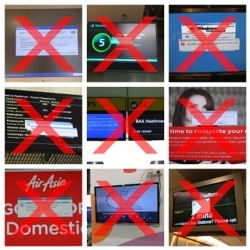 What is Web signage? It’s the future of signage aka DOOH. Powered by Linux.
What is Web signage? It’s the future of signage aka DOOH. Powered by Linux.
Allow me to explain.
First generation sign – Static
An etching on a cave wall, to a flashing Neon sign. These are static signs usually fixed to a particular location. Their often cumbersome to replace, though are pretty simple and reliable.
Second generation sign – Digital
Using usually a standard TV screen, a series of images are displayed in rotation or a video is simply looped. Some televisions are capable of being programmed to become a sign, simply by inserting a USB stick. Most solutions sadly fail to provide a polished out of the box solution for this use case, requiring someone to setup the DVD player or re-configure the software on the “SMART TV”, every single time that device is power cycled or fails. Awkward.
Even though most “SMART TV”s are powered by Linux, typically TV manufacturers provide no documentation or way to modify the existing software to stream line this relatively simple use case. Which is a shame.
This generation of signage is where we are mostly at the moment. Advertisers like this as they can convey “experiences” well with short clips, sometimes with an annoying sounded message, in rotation. They are usually easy to update, but often they are not for hours at a time, since most of them use a USB stick as their source which manually needs to be swapped out.
Third generation sign – Internet powered
There are many players in the “DOOH” industry vying for your custom, peddaling their own proprietary systems that lock customers onto their particular platform, e.g. BrightSign or Harris are leading examples.
You can recognise these locked in systems easily because they are not Web powered or confusingly embrace and extend the Web.
There are even “opensource” platforms to create signage content, but since they do not use Web standards to layout the content, they should be avoided, as they are effectively locking you into their format only they control.
Note that all you need to configure a proper Web signage operating system is a URL. So switching between Web signage players should be even easier than switching between Chrome & Firefox today.
There are a couple of major stumbling blocks to Web signage, the first being that many advertisers and “DOOH” content producers are really quite poor at creating and managing Web content with information.
The second is that the “Web sign” playback devices are typically clumsily put together boxes running a full screen browser, with no “polish”.
I don’t have quick solutions to offer for the first problem, though for the second problem, one solution is Webconverger Neon.
It runs Linux. It’s opensource It supports a wide range of hardware. It’s stable. It keeps the browser upto date, supporting the latest standards like the Web Video Text Tracks Format.
Furthermore Webconverger Neon is polished, if it fails in often hostile outdoor environments, such as a hardware issue of loss of connectivity, it defaults to a black screen. No silly network can’t be found messages. No blue screens. No modal dialog boxes. And then network/hardware is restored, it lights back up as best it can as it’s retrying in the background.
As for networked Web signage itself, information can be delivered as fast as a Web page takes to load. Images, videos and other HTML useful technologies such as caching can be used to deliver useful information. Just like your favourite Web application.





